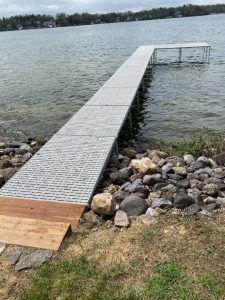A well-maintained railing system doesn’t just enhance your property’s aesthetic appeal—it’s essential for safety and longevity. Whether you have wooden, metal, glass, vinyl railings, or boat dock railing systems, proper maintenance can extend their lifespan by decades while preventing costly repairs. Neglecting your railings can lead to structural weaknesses, safety hazards, and expensive emergency replacements that could have been avoided with simple preventive care. The good news is that maintaining your railing system doesn’t require professional expertise or significant time investment. With the right knowledge and a consistent routine, you can protect your investment and ensure your railings remain secure and beautiful for years to come. Here’s your comprehensive guide to keeping your railing system in excellent condition.
Understanding Your Railing Material
Different materials require different care approaches. Before diving into maintenance, identify what type of railing system you have—including whether it’s one of the boat dock railing systems—as this will determine your maintenance schedule and methods.
Wood Railings
Wood railings offer classic beauty but require the most attention. Exposure to moisture, UV rays, and temperature fluctuations can cause warping, cracking, and rot if left unaddressed.
Annual Maintenance Tasks:
- Inspect for signs of rot, particularly at post bases and joints where moisture accumulates
- Check for loose fasteners and tighten or replace as needed
- Sand down any rough or splintered areas to prevent injuries
- Apply a fresh coat of sealant, stain, or paint to protect against moisture and sun damage
Seasonal Care:
- Clean with mild soap and water every few months to remove dirt and mildew
- Trim nearby vegetation to improve air circulation and reduce moisture retention
- Address any water pooling issues around post bases immediately
Metal Railings (Aluminum, Steel, Wrought Iron)
Metal railings are durable and low-maintenance, but they’re not maintenance-free. The primary concern with metal systems is corrosion.
Regular Maintenance:
- Inspect for rust spots, particularly on steel and wrought iron systems
- Clean with soapy water and a soft brush to remove dirt and salt buildup
- Address rust immediately by sanding the affected area and applying rust-inhibiting primer and paint
- Check welds and joints for cracks or weakening
Aluminum Advantage: Aluminum railings resist rust naturally but can develop oxidation. A simple wash with mild detergent keeps them looking fresh. Apply automotive wax annually for added protection and shine.
Steel and Wrought Iron: These require more vigilant rust prevention. Reapply protective coating every two to three years, or sooner in coastal or high-humidity environments.
Glass Railings
Glass railing systems provide unobstructed views and modern aesthetics. While the glass panels themselves are low-maintenance, the mounting hardware requires attention.
Maintenance Routine:
- Clean glass panels regularly with glass cleaner or a mixture of vinegar and water
- Use a squeegee to prevent water spots and streaking
- Inspect mounting hardware for corrosion or loosening
- Check gaskets and spacers for wear and replace if damaged
- Ensure drainage holes in the frame system remain clear
Vinyl and Composite Railings
These synthetic materials offer excellent durability with minimal upkeep, making them increasingly popular for residential applications.
Simple Care:
- Wash with soap and water several times per year
- Remove stubborn stains with a non-abrasive cleaner
- Inspect for cracks or fading, though quality products rarely experience these issues
- Check mounting brackets and fasteners annually
Read More:- Warning Signs Your Boat Dock Needs Repair (Before It’s Too Late)
Universal Maintenance Practices
Regardless of material, certain maintenance practices apply to all railing systems:
Structural Integrity Checks
Perform these inspections at least twice yearly:
Posts and Anchoring: Test each post for stability by applying gentle pressure. Posts should not wobble or shift. Loose posts indicate failing anchors that need immediate attention, as they compromise the entire system’s safety.
Fasteners and Connections: Examine all screws, bolts, and brackets. Outdoor environments cause fasteners to loosen over time through thermal expansion and contraction. Tighten any loose hardware and replace corroded fasteners with stainless steel or other corrosion-resistant options.
Baluster Spacing: Building codes typically require balusters to be spaced no more than four inches apart to prevent small children from slipping through. Check that spacing hasn’t changed due to settling or warping.
Cleaning Best Practices
Regular cleaning prevents buildup that can lead to deterioration:
- Use gentle cleaning solutions appropriate for your material
- Avoid pressure washers on wood railings, as they can damage the surface
- Work from top to bottom to prevent streaking
- Rinse thoroughly to remove all cleaning solution residue
- Clean in mild weather to avoid rapid drying that causes spotting
Weather Protection
Environmental factors are the primary cause of railing deterioration:
Sun Protection: UV rays fade finishes and weaken materials over time. Apply UV-protective coatings to wood and regularly inspect other materials for sun damage.
Moisture Management: Water is wood’s enemy and accelerates metal corrosion. Ensure proper drainage around post bases and fix any areas where water collects.
Winter Care: In cold climates, remove snow and ice buildup promptly. Salt and de-icing chemicals are particularly corrosive to metal. Rinse railings after winter storms if salt exposure occurs.
Creating Your Maintenance Schedule
Consistency is key to long-term durability. Here’s a simple schedule to follow:
Monthly (5 minutes): Visual inspection for obvious damage or loose components
Quarterly (30 minutes): Thorough cleaning and basic stability testing
Annually (2-3 hours): Comprehensive inspection, refinishing as needed, and hardware replacement
Every 2-5 Years: Major refinishing projects like repainting or restaining wood railings
When to Call a Professional
While most maintenance is DIY-friendly, certain situations require professional expertise:
- Structural damage or significantly loose posts
- Extensive rust or rot requiring component replacement
- Code compliance concerns
- Complex repairs to glass mounting systems
- Signs of foundation settlement affecting railing stability
The Bottom Line
Your railing system is a significant investment in your property’s safety, functionality, and curb appeal. Whether you’re maintaining standard railings or boat dock railing systems, regular attention and proper care will help them serve you reliably for decades. The time you invest in upkeep now prevents expensive replacements later while ensuring your railing system remains safe, sturdy, and attractive.
Start with a thorough inspection this week, create a maintenance calendar, and commit to regular care. Your future self—and your wallet—will thank you.
Final Thoughts
Maintaining your railing system doesn’t have to be overwhelming. A few minutes of attention each month can prevent years of problems and preserve your investment. Whether you’re dealing with the natural beauty of wood, the sleek look of glass, or the durability of metal, consistent care is the key to longevity. With support from JD Hellenbrand, you can keep your entire setup in strong condition year-round.
Remember, a well-maintained railing system does more than look good—it keeps your family and guests safe. Don’t wait for problems to become obvious. Start your maintenance routine today, and enjoy the peace of mind that comes with knowing your railings are secure, beautiful, and built to last. If you’re ready to strengthen or upgrade your setup, visit our contact page to get started.


